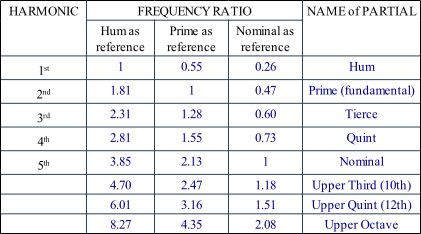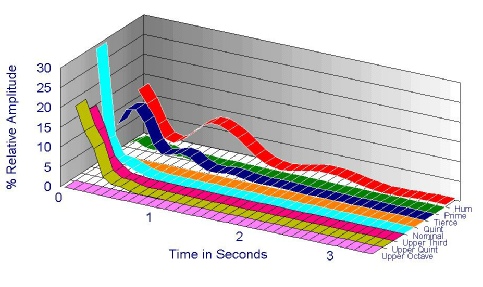


UK Registered Charity Number: 1154107

Conservation by Re-use
Helping churches acquire surplus and/or redundant bells to be hung for
English-style full-circle bell-ringing.


 Index
Previous page
Next page
Index
Previous page
Next page

 Listen to the Bell
Listen to the Bell
Partials of a typical 19th Century Bell
Typical Harmonic Spectrum for an early 19th Century bell
Simpson advocated a scale where a bell's partials are related to each other by fixed ratios i.e. like Wind and String instruments. He also advocated the partials should be the common chord of the prime, major third, fifth and octave with the hum note an octave lower. Taking the lowest frequency as the reference he suggested harmonic series should be 1 : 2 : 2.5 : 3 : 4. He supposed this combination would allow a bell to be in-tune with itself, resulting in a ring of bells to sound in-tune when rung traditionally and also when chimed. For the bell-founder, who takes the nominal as the reference, it would mean a slight decrease in frequency of the Hum and a slight increase in frequency of the Prime and Tierce.
Sound of Bells – Simpson’s Hypothesis
The rapid advances now being made promise very soon to render it as easy for the musician to analyse any tone however complex as it is for the chemist to resolve a compound into its component simple elements. These words were written by John Llewellin junior of the bell-founding firm Llewellin & James in 187910.
During the Victorian period, some bell-founders and amateurs were conducting research to improve the tonal qualities of bell castings. This information was considered commercially sensitive and little research was published. Many bell-founders were aware of the research by Chladni into the modes of vibration of a disk11, and most if not all were fully aware of a bell's nodal meridians and circles. Prior to Canon Simpson's1 article it had been assumed by some bell-founders that tonal quality problems could be overcome by increasing the thickness of various parts of the bell to reduce individual partial intensities12) .